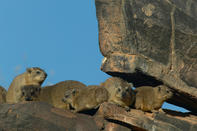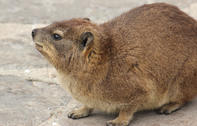Thermolabile and Heaping

Dassies are strictly diurnal and will return to their dens before sunset and only emerge well after sunrise unless the temperatures are particularly warm (in which event they may remain out for slightly longer).
Because they live in isolated habitats and rely on bolt holes for safety, dassies tend to utilize their available food heavily with the result that only poor quality forage is available to them much of the time. Since making forays further than 500 m to nearby riverine areas for food is too dangerous, they have developed a unique way of saving energy to reduce their intake requirements. Dassies are thermolabile meaning that they can regulate their own body temperature.
By allowing the body temperature to drop a few degrees, they can save metabolic energy and then they regain the heat through basking in the sun, which they do religiously every day. On cold days dassies may remain in their dens and huddle to share body heat.
They also save energy by spending very little time (only 5%) actively feeding or moving around. Dassies do not handle lengthy exposure to heat well and will retreat into the shade when the sun gets too hot or may spread out their bodies with sides or bellies against the rocks to dissipate heat via the rocks. Dassies practice a heat-sharing activity known as ‘heaping’. This is where layers of huddling dassies form one upon the next and up to four layers deep.
Each layer arranges itself such that their rumps face inwards and their heads outwards (to allow for breathing). The young are often on the top. As a result of the close personal contact, all the members of a group develop a common odour. This identifies them one to the other and any strangers without the communal smell will be chased off. Newborn babies crawl onto the backs of the adults shortly after birth in order to obtain the group scent.
Dorsal Spot

In the middle of the dassie’s back is a patch with longer hair than elsewhere.
This is the dorsal spot and it covers the dorsal gland. The exact function of the gland is unknown but it is suggested that it plays a role in individual recognition especially since during huddling and heaping individuals noses come into close contact with another’s patch.
The hair of the dorsal spot is erectile and during bouts of aggression involving growling and the baring of teeth, this hair is erected. Aggressive displays are used to displace individuals from favoured sunning spots or to gain access to food.
The displaced or submissive individual keeps its dorsal hair flat. These interactions prevent actual fighting, which may result in injury.
By Megan Emmett